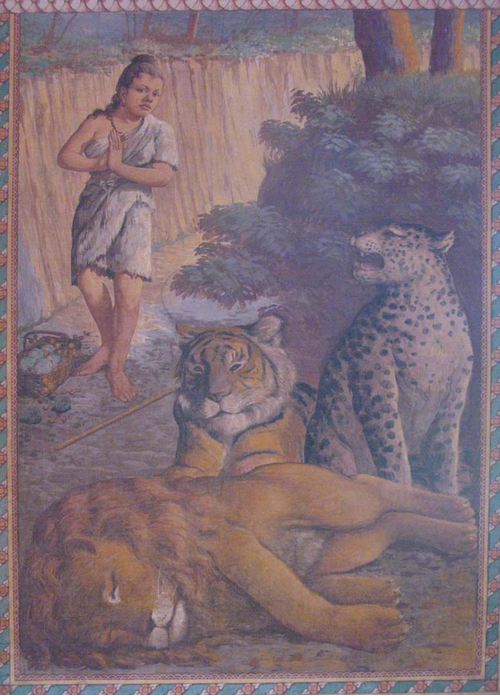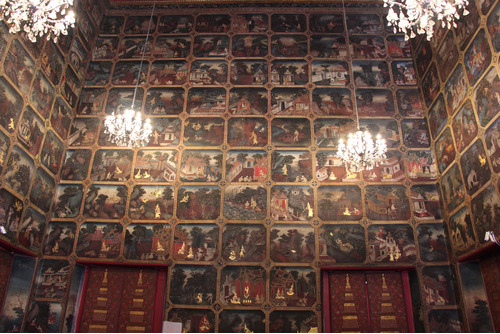ค้นหางานศิลปกรรม
ฐานข้อมูลศิลปกรรมในเอเชียตะวันออกเฉียงใต้
จิตรกรรมจิตรกรรมเรื่องเวสสันดรชาดก
ภาพมหาเวสสันดรชาดกมีฉากใหญ่ที่ผนังเหนือช่องหน้าต่างและประตูรวม 3 ด้าน เรียงลำดับจากด้านขวาของพระประธาน ได้แก่ ผนังด้านทิศใต้เป็นฉากกัณฑ์หิมพานต์ เล่าเหตุการณ์ตอนพระเวสสันดรทรงบริจาคช้างปัจจัยนาเคนทร์แก่พราหมณ์เมืองกลิงคราษฎร์ ซึ่งเป็นเหตุให้ชาวเมืองสีพีไม่พอใจ ทำให้พระเวสสันดร พระนางมัทรีและพระโอรสธิดาต้องถูกเนรเทศออกจากเมือง ผนังด้านทิศตะวันออกเป็นฉากทานกัณฑ์ เล่าเหตุการณ์ขณะพระเวสสันดรเสด็จออกจากกรุงสีพีและได้ทรงบริจาคทางตลอดเส้นทางที่มุ่งหน้าสู่ป่าหิมพานต์แม้กระทั่งม้าเทียมรถและราชรถ ผนังด้านทิศเหนือเป็นฉากนครกัณฑ์ เล่าเหตุการณ์ในตอนจบที่กษัตริย์ทั้งหกเสด็จกลับสู่เมืองสีพีด้วยกระบวนอิสริยยศ โดยมีฉากพระราชวังที่ละม้ายคล้ายกับพระมหาปราสาทในพระบรมมหาราชวัง ส่วนภาพเหตุการณ์สำคัญจากกัณฑ์อื่นๆ อยู่บริเวณผนังระหว่างช่องหน้าต่าง ซึ่งมีการจัดวางองค์ประกอบโดยให้บุคคลสำคัญของเรื่องอยู่ใจกลางภาพ แวดล้อมด้วยฉากสถานที่หรือทิวทัศน์อย่างสมจริงตามเรื่องราวในชาดก
ประติมากรรมใบเสมา
ใบเสมาแผ่นแบนมียอดแหลม สลักภาพเล่าเรื่องอยู่ทางด้านหน้า เป็นภาพพระอินทร์พร้อมด้วยชายาและช้างเอราวัณ พระอินทร์นั่งในท่าลลิตาสนะอยู่ตรงกลาง ถือวัชระไว้ในพระหัตถ์ซ้าย ต้นไมทางเบื้องหลังสันนิษฐานว่าเป็นต้นปาริชาติ อันเป็นต้นไม้ประจำสวรรค์ชั้นดาวดึงส์ซึ่งเป็นสวรรค์ของพระอินทร์ เบื้องซ้ายของพระองค์มีภาพบุคคล 3 คน และนก 1 ตัว เป็นภาพชายาทั้ง 4 ของพระอินทร์ ได้แก่ สุธรรมา สุจิตรา สุนันทา และสุชาดาซึ่งกลับมาเกิดเป็นนกยาง เพราะไม่ได้สั่งสมบุญไว้เพียงพอ ด้านหลังของกลุ่มชายาเป็นลวดลายกนกแบบทวารวดีซึ่งคงสื่อถึงก้อนเมฆ ด้านขวาของพระอินทร์มีช้างเอราวัณ
จิตรกรรมจิตรกรรมเรื่องชาดก 550 ชาติ
ผนังรอบพระอุโบสถแบ่งเป็นช่องสี่เหลี่ยมขนาดเท่าๆกัน เขียนลายกระหนกเป็นกรอบ ภายในช่องเขียนภาพชาดกแตกต่างกัน และมีข้อความกำกับใต้ภาพแต่ละเรื่อง ชาดกแต่ละเรื่องนำเสนอผ่านฉากเหตุการณ์สำคัญในแต่ละตอน ภาพบุคคลสำคัญเช่นพระโพธิสัตว์ เทวดา กษัตริย์ปิดทองที่เครื่องทรง มีกิริยาอย่างนาฏลักษณ์ ภาพอาคารมีที่เป็นรูปแบบอาคารอย่างไทยประเพณี อาคารแบบจีน บ้านเรือนผู้คนที่มีรูปแบบตามสมัยนิยม
จิตรกรรมจิตรกรรมเรื่องมโหสถชาดก
เนื้อหาภาพจิตรกรรมเป็นเรื่องราวตามแบบแผนประเพณี เช่น เรื่องพุทธประวัติ เทพชุมนุมทศชาดก และไตรภูมิโลกสัณฐาน จึงแสดงความสมจริงตามเรื่องราวอันเป็นปรัมปราคติ แต่ในขณะเดียวกันภาพจิตรกรรมยังได้สะท้อนแนวคิดแบบสมจริงอย่างเป็นเหตุเป็นผล ที่เกิดจากทัศนคติอย่างตะวันตกที่เริ่มแพร่เข้ามาในสมัยรัชกาลที่ 3 ดังจะเห็นได้จากรายละเอียดอันเป็นความสมจริงในฉากต่างๆ ไม่ว่าจะเป็นอาคารบ้านเรือน วิถีชีวิตผู้คน ซึ่งมีสอดแทรกจากภาพที่เป็นเนื้อหาหลัก ภาพจิตรกรรมยังปรากฏเทคนิคการเขียนภาพแบบไทยประเพณี เช่น ภาพกษัตริย์ มเหสี ที่เขียนอย่างตัวพระ ตัวนางในวรรณคดีที่แสดงออกด้วยท่านาฏลักษณ์ การปิดทองคำเปลวในส่วนสำคัญต่างๆ ฉากเหตุการณ์ต่างๆ ใช้พื้นหลังสีเข้ม จึงขับเน้นให้ภาพปราสาทราชวัง อาคารบ้านเรือน รวมทั้งตัวละครที่มีสีอ่อนกว่าและปิดทองในบางตำแหน่งให้มีความโดดเด่นมากยิ่งขึ้น
ประติมากรรมภาพชาดกดินเผา เรื่องพระมหาชนก
เจดีย์เป็นเล็กเป็นเจดีย์ทรงระฆังสมัยพุกามตอนต้น ได้รับอิทธิพลปาละ ที่ส่วนฐานปรากฏระเบียงซึ่งบรรจุภาพดินเผาเล่าเรื่องชาดกจำนวน 550 พระชาติ ภาพชาดกดังกล่าวทำจากดินเผาที่ยังไม่ได้เคลือบเขียวซึ่งแตกต่างไปจากเจดีย์ชเวซิกอง แสดงให้เห็นวาภาพชาดกนี้อาจอยู่ในสมัยก่อนพุกามหรือพุกามตอนต้นระยะแรก
ประติมากรรมภาพชาดกดินเผา เรื่องสุวรรณสาม
เจดีย์เป็นเล็กเป็นเจดีย์ทรงระฆังสมัยพุกามตอนต้น ได้รับอิทธิพลปาละ ที่ส่วนฐานปรากฏระเบียงซึ่งบรรจุภาพดินเผาเล่าเรื่องชาดกจำนวน 550 พระชาติ ภาพชาดกดังกล่าวทำจากดินเผาที่ยังไม่ได้เคลือบเขียวซึ่งแตกต่างไปจากเจดีย์ชเวซิกอง แสดงให้เห็นวาภาพชาดกนี้อาจอยู่ในสมัยก่อนพุกามหรือพุกามตอนต้นระยะแรก
ประติมากรรมมหากปิชาดก
รูปแบบศิลปะของภาพสลักที่บุโรพุทโธมีความคล้ายคลึงศิลปะอินเดียเป็นอย่างมาก ทั้งรูปแบบเครื่องแต่งกายของประติมากรรม ข้าวของเครื่องใช้ ตัวละครที่กลมกลึงและมีการเว้นพื้นที่ว่างเปล่า ทั้งหมดนี้แสดงว่าศิลปะชวาภาคกลางมีความเกี่ยวข้องอย่างมากกับศิลปะอินเดีย
ประติมากรรมกัจฉปาวทาน
รูปแบบศิลปะของภาพสลักที่บุโรพุทโธมีความคล้ายคลึงศิลปะอินเดียเป็นอย่างมาก ทั้งรูปแบบเครื่องแต่งกายของประติมากรรม ข้าวของเครื่องใช้ ตัวละครที่กลมกลึงและมีการเว้นพื้นที่ว่างเปล่า ทั้งหมดนี้แสดงว่าศิลปะชวาภาคกลางมีความเกี่ยวข้องอย่างมากกับศิลปะอินเดีย





